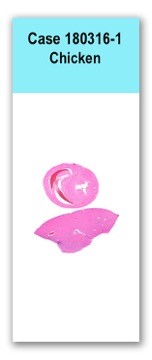Case 1 180316-1 (D0401828)
Conference Coordinator: Dr Patty Pesavento and Dr Kevin Keel.
//
Chicken (adult hen); Gallus gallus domesticus
This was a backyard hen that was found dead. The owner has a small (<12) flock.
There were scattered pale, white irregular to oblong foci, the largest & 4mm throughouthe myocardium with left ventricle most affected and where some of foci were coalescing those that extended to subepicardium slightly bulged above ventricular wall focally lifted epicardium there was 2mls fluid in pericardial space.
The ventricular and septal walls are disrupted in multifocal to coalescing regions by large numbers of macrophages and fewer lymphocytes and heterophils that separate, replace, compress and, in some regions, destroy cardiac myocytes. The lesions are more severe on the left side. Similar inflammatory cell infiltrates are present that extend to the endocardium, and, in some regions, the inflammation forms irregularly shaped nodules that bulge the epicardial surface. Macrophages are loosely central in the foci, and have large vesicular nuclei and foamy, pale eosinophilic cytoplasm. Cardiac myocytes that abut the inflammatory regions are often pale and have a swollen and vacuolated cytoplasm (degeneration), or have fragmented sarcoplasm with loss of cross striations and pyknotic nuclei (necrosis). Multifocally, the inflammation extends to the intima of epicardial veins and in one section a medium sized artery. In this segment the arteriolar wall is disrupted and segmentally the wall is replaced by intense eosinophilic fibrillar material (interpreted as fibrin).
N/A
Heart: Severe, multifocal to coalescing, granulomatous myocarditis with myocardial degeneration and loss, and moderate, multifocal, chronic fibrinonecrotizing vasculitis.
Pullorum disease (PD) is caused by Salmonella pullorum. Chickens and turkeys are the most significant species affected, however other game birds can be affected In poultry PD is primarily a disease of chicks and poults resulting from transovarian (vertical) transmission. The gross lesions in young birds reflect a bacterial sepsis and in addition to pale necrotic inflammatory foci can include visceral congestion, caseous yolk material (ovaries are commonly targeted), pale nodules in the lungs, and swollen joints. Conference commentators noted that because of the white nodular appearance in the heart in particular, a gross differential is often Mareks disease. Infections can also localize in joints and tendon sheaths where they would resemble infections by Mycoplasma synoviae, Staphylococcus aureus, Pasteurella multocida, or Erysipelothrix rhusiopathiae.
The vascular lesions, consisting of a true vasculitis, were interesting. There was some discussion about how predictable vascular involvement is in this disease, without clear consensus. California has instigated, and been relatively successful, at control and eradication of S. pullorum from commercial poultry flocks, primarily by serologic screening of flocks.Wigley P, Berchieri A Jr, Page KL, Smith AL, Barrow PA.Salmonella enterica serovar Pullorum persists in splenic macrophages and in the reproductive tract during persistent, disease-free carriage in chickens. Infect Immun. 2001 Dec;69(12):7873-9
Shivaprasad HL. Fowl typhoid and pullorum disease. Rev Sci Tech. 2000 Aug;19(2):405-24
Case contributor:This case was contributed by Dr. Patricia Pesavento, UC Davis, School of Veterinary Medicine.
